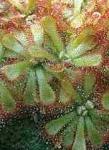|
|
DroseraFamily: Insectivores.
|
Common name(s): Sundew, Cape Sundew, Forked Sundew |
|
 |
Family: Droseraceae.
Genus of about 100 species of rosette-forming or scrambling, evergreen or herbaceous, insectivorous perennials, also including some annuals, found in poor, acidic, boggy soil throughout the world, but mainly in Australia. Drosera (Sundew) bears a rosette of leaves covered with red hairs. These hairs secrete the juices which both trap and digest the insects. Drosera binata is an Australian Sundew (Forked Sundew) which bears lond and deeple-lobed leaves. Stem short; leaves basal, erect, stipuled, petiole to 14 inches long, glabrous, blade forked into 2 or 4 segments, segments linear, to 6 inches long; scape to 20 inches high or more, glabrous, branched in upper part, many-flowered; petals 5, white, to 1/2 inch long. Carnivorous.
The American Drosera capensis (Cape Sundew) has undivided leaves. Stems short to elongate; leaves crowded, stipuled, petiole dilated at base, glabrous or sparsely pubescent, 1.5 - 4 inches long, blade linear to spatulate-linear, 1.5-2.25 inches long; scape 8-14 inches high, hairy, glandular in upper part, 6-20 flowered; petals 5, purple, to 3/8 inch long. Carnivorous. |
|
| Growing conditions |
Watering and misting |
Propagation |
| Average warmth in summer - minimum 40 F in winter. Brightly lit spot away from direct sunlight. Use in a bog garden. Grow in acidic potting mix. |
Keep compost moist at all time. Reduce watering in winter. Misting is necessary. Use rainwater. |
Divide plants in spring. Take leaf cuttings. Sow seed at 50-55 F (10-13 C) as soon as ripe. |
|
These materials are freely provided for instructional and educational purposes. Any duplication or publication of text or images herein for commercial gain without explicit written permission of the owner or photographer constitutes breach of trust and violation of copyright.
Copyright © Galka Okhapkina 1998-2026

